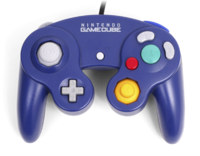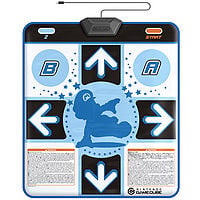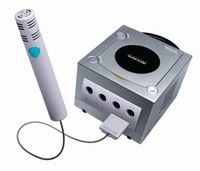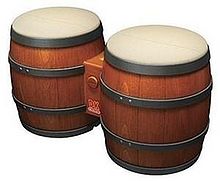Nintendo GameCube: Difference between revisions
No edit summary |
mNo edit summary |
||
| Line 13: | Line 13: | ||
The Nintendo GameCube utilizes game discs that are the size of an MP3 disc. Also, when compared to the [[Nintendo 64]] game cartridges, GameCube game discs can hold more memory; up to 1.35 GB (1,459,978,240 bytes). | The Nintendo GameCube utilizes game discs that are the size of an MP3 disc. Also, when compared to the [[Nintendo 64]] game cartridges, GameCube game discs can hold more memory; up to 1.35 GB (1,459,978,240 bytes). | ||
There are four main colors to the Nintendo GameCube. Purple, Black, Orange, and Silver. Purple is the original color seen in advertisements, the trophy in [[Super Smash Bros. Melee]], and other places. Silver was released after the first three colors. Orange was not available in the U.S., but controllers matching its color were. | There are four main colors to the Nintendo GameCube. Purple, Black, Orange, and Silver. Purple is the original color seen in advertisements, the trophy in ''[[Super Smash Bros. Melee]]'', and other places. Silver was released after the first three colors. Orange was not available in the U.S., but controllers matching its color were. | ||
Many popular [[Mario (series)|Mario games]] were made for this system, including: ''[[Super Mario Sunshine]]'', ''[[Paper Mario: The Thousand-Year Door]]'', ''[[Super Smash Bros. Melee]]'', ''[[Mario Kart: Double Dash!!]]'', ''[[Mario Superstar Baseball]]'' and ''[[Luigi's Mansion]]''. | Many popular [[Mario (series)|Mario games]] were made for this system, including: ''[[Super Mario Sunshine]]'', ''[[Paper Mario: The Thousand-Year Door]]'', ''[[Super Smash Bros. Melee]]'', ''[[Mario Kart: Double Dash!!]]'', ''[[Mario Superstar Baseball]]'' and ''[[Luigi's Mansion]]''. | ||
Revision as of 13:29, February 14, 2012
Template:Articleabout Template:System-Infobox Template:LLQuote
The Nintendo GameCube is a console system developed by Nintendo, and released towards the end of 2001. The GameCube's preproduction codename name was "Project Dolphin", as noted references appear in games such as Super Mario Sunshine. The GameCube has room for two memory cards and four controllers. It has three buttons on top: Open, Reset, and Power. It has two serial ports and one hi-speed port on the bottom; their respective functions remain a mystery.
The Nintendo GameCube utilizes game discs that are the size of an MP3 disc. Also, when compared to the Nintendo 64 game cartridges, GameCube game discs can hold more memory; up to 1.35 GB (1,459,978,240 bytes).
There are four main colors to the Nintendo GameCube. Purple, Black, Orange, and Silver. Purple is the original color seen in advertisements, the trophy in Super Smash Bros. Melee, and other places. Silver was released after the first three colors. Orange was not available in the U.S., but controllers matching its color were.
Many popular Mario games were made for this system, including: Super Mario Sunshine, Paper Mario: The Thousand-Year Door, Super Smash Bros. Melee, Mario Kart: Double Dash!!, Mario Superstar Baseball and Luigi's Mansion.
An add-on accessory for the Nintendo GameCube known as the Game Boy Player, was released in 2003. The Game Boy Player allowed people to play Game Boy Advance titles on their television screen through their GameCube. The GameCube was discontinued in 2007. It sold 22 million units during its lifetime.
Accessories
Nintendo GameCube Controller

The Nintendo GameCube Controller is the standard controller for the Nintendo GameCube. It consists of several buttons, of many types. The Nintendo GameCube gets shipped with controllers capable of rumble effect. These controllers can also be used to play some Virtual Console games on the Wii, and is also one of the four controller types available in Super Smash Bros. Brawl and Mario Kart Wii.
Buttons
The GameCube regained the ![]() and
and ![]() buttons from the SNES that the Nintendo 64 didn't have.
buttons from the SNES that the Nintendo 64 didn't have.
- A (
 )
) - B (
 )
) - C Stick (
 )
) - START/PAUSE (
 )
) - X (
 )
) - Y (
 )
) - Z (
 )
) - R trigger (
 )
) - L trigger (
 )
) - Control Stick (
 )
) - Control Pad (
 )
)
GameCube Action Pad
The Nintendo GameCube Action Pad is a special controller for the Nintendo GameCube. The only Mario game it is used for is Dance Dance Revolution: Mario Mix. It has some, but not all, of the Nintendo GameCube Controller's buttons.
Buttons
- A
- B
- START
- Z
- Left
- Right
- Up
- Down
Nintendo GameCube Microphone
The Nintendo GameCube Microphone is a special accessory used for the Nintendo GameCube and Wii (for GameCube games). It is unusual, in the fact that it is plugged into the Memory Card slot, rather than the controller slot. It has been used in Mario Party 6 and Mario Party 7 as a tool for playing any mic mini-game. Because Mario Party 8 was for the Wii, it did not use the Microphone or any other voice-activated commands.
Mic minigames in Mario Party 6
DK Bongos
DK Bongos are bongo-like controllers for the Nintendo GameCube - the Donkey Kong(a) series utilizes them for the most part. Each side of the controller is shaped like a classic Donkey Kong barrel with a rubber drum skin fastened on top. It also has a built-in microphone to detect clapping (although hitting the sides of it also functions well). In the Donkey Kong(a) series, the DK Bongos detect left and right hits, and clapping.
In Japan the controller is called the TaruKonga (or "TaruConga") controller. The name is a multilayered pun, combining "Taru" (the Japanese word for "barrel"), "Kon", or "Con" (a suffix used by Namco when naming their original peripherals, such as the "GunCon", or the "TaTaCon"), and Konga (or Conga).
The DK Bongos are also confirmed to be compatible with the Wii.[1]
Games that uses the DK Bongos
- Donkey Konga
- Donkey Konga 2
- Donkey Konga 3: Tabe-houdai! Haru Mogitate 50 Kyoku
- Donkey Kong Jungle Beat
Appearances in Mario games
Super Smash Bros. Melee
A GameCube is a trophy in Super Smash Bros. Melee. The only platform in Luigi's Target Test is a GameCube.
Mario Party series
Though a GameCube doesn't actually appear in Mario Party 4, the Party Cube is a reference to the GameCube, and the rumble machine in the options screen is clearly based on the GameCube. Additionally, a GameCube can be seen inside the shops of Mario Party 6 and Mario Party 7, though not on the counter.
Wario World
One of Wario's Treasures in Wario World is a Nintendo GameCube, found in a pink chest in Pecan Sands.
Mario Kart: Double Dash!!
The Nintendo GameCube battle course in Mario Kart: Double Dash!! is just a GameCube. This Nintendo GameCube logo can also appear at the bottom of the word "Mario Kart" on the five pointed star in Mario Circuit and Sherbet Land. The logo can also be seen on the billboards at Mushroom City.
Paper Mario series
In Paper Mario: The Thousand-Year Door the pink Bob-omb who runs the lottery in the west of Rogueport will mention the Gamecube's time.
In Super Paper Mario, Francis owns a GameCube which he keeps in his room with several other game systems.
Super Mario 64 DS
In Super Mario 64 DS, the GameCube logo appears in the map of the castle garden.
WarioWare: Touched!
In WarioWare: Touched!, one of the falling objects during the credit reel is a GameCube logo.
Hardware Specifications
- MPU ("Microprocessor Unit")*: Custom IBM Power PC "Gekko"
- Manufacturing process: 0.18 micron IBM copper wire technology
- Clock frequency: 485 MHz
- CPU capacity: 1125 Dmips (Dhrystone 2.1)
- Internal data precision : 32-bit Integer & 64-bit floating-point
- External bus: 1.3GB/second peak bandwidth (32-bit address space, 64-bit data bus 162 MHz clock)
- Internal cache L1: instruction 32KB, data 32KB (8 way) L2: 256KB (2 way)
- System LSI: Custom ATI/Nintendo "Flipper"
- Embedded frame buffer: Approx. 2MB sustainable latency : 6.2ns (1T-SRAM)
- Embedded texture cache: Approx. 1MB sustainable latency : 6.2ns (1T-SRAM)
- Texture read bandwidth: 10.4GB/second (Peak)
- Main memory bandwidth: 2.6GB/second (Peak)
- Pixel depth: 24-bit color, 24-bit Z buffer
- Image processing functions: Fog, subpixel anti-aliasing, 8 hardware lights, alpha blending, virtual texture design, multi-texturing, bump mapping, environment mapping, MIP mapping, bilinear filtering, trilinear filtering, anisotropic filtering, real-time hardware texture decompression (S3TC), real-time decompression of display list, HW 3-line deflickering filter.
Trophy Information from Super Smash Bros. Melee
Nintendo's latest bundle of joy arrived in North America on November 18, 2001, and video-game fans rejoiced. This little beauty is sleek, compact and full of cutting-edge technology. Incorporating optical media for the first time, the Nintendo GameCube was truly born to play. Rumor has it that Super Smash Bros. Melee is a software title for this wondrous device.
Game Gallery
- Lmbox.jpg
- ToadstoolTour.PNG
- Mpp4.JPG
- MP5BOX.PNG
- MP7BOX.PNG
- 200px-Super mario sunshine.jpg
- Super Smash Bros Melee Players Ch.jpg
Trivia
- One of the GameCube launch title Luigi's Mansion was released in North America on November 17, 2001. This is odd, however, as the GameCube itself was released in North America one day later.
- The DK Bongos, a GameCube accessory, are featured in Super Smash Bros. Brawl as Donkey Kong's Final Smash attack, the "Konga Beat."
- This Directional Pad or the + pad on the Nintendo GameCube Controller had the same size and shape as the original Game Boy Advance.
- When holding
 upon turning the system on instead of the original sound it will play the sounds of a xylophone, spring, and children laughing.
upon turning the system on instead of the original sound it will play the sounds of a xylophone, spring, and children laughing. - When holding
 on all four controllers upon turning the system on, it will play kabuki style music with bongos and vocalization.
on all four controllers upon turning the system on, it will play kabuki style music with bongos and vocalization. - When sped up 16 times, the menu ambience is the same as the original Famicom Disk System start-up tune.[2]
- Super Paper Mario and Donkey Kong Barrel Blast (while under the working title of DK Bongo Blast) were originally going to be released for the GameCube, however they were moved to the Wii.

















